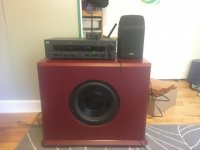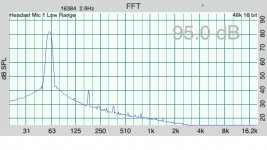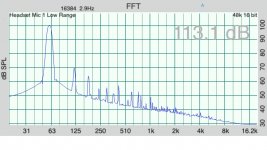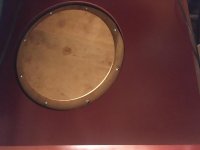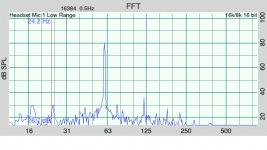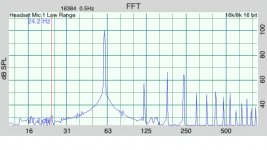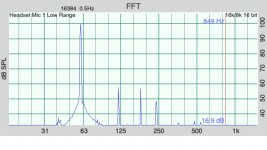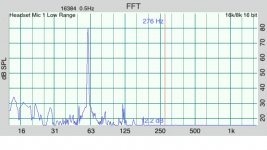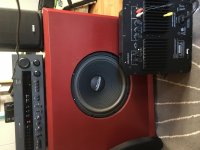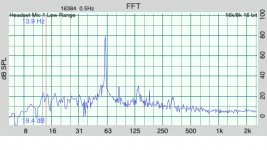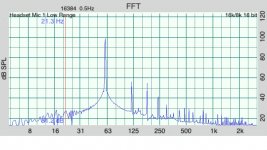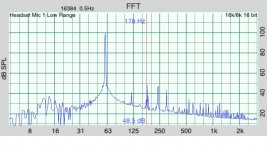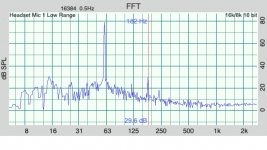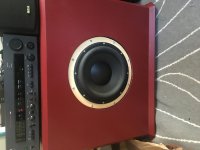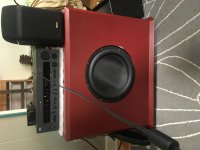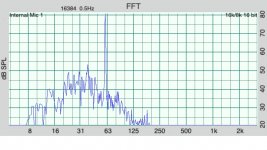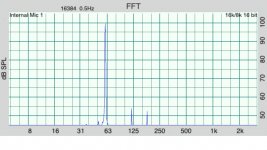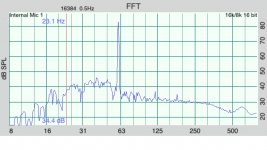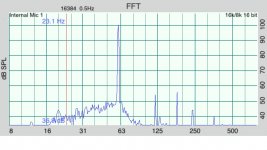In July I picked up a dayton audio RS1202A Dual subwoofer on the used market. I was very excited about this purchase it uses two 12" dayton reference series subwoofers in 2.1 cu ft (60 liter) of airspace with a SPA1000 plate amplifier.
However, I did not really like the sound of this setup. I'm not sure if the suspension is too stiff or the inductance or moving mass is too high but it seems to miss the peak spl of a kick drum hit and can't keep up with quick notes on a bass guitar. I know there is a lot of opinions of subwoofer transient response and I don't really want to get into that discussion, but I am running these up to 100hz so I am possibly getting into territory where the ear is more sensitive to transient response.
I then decided to take distortion measurements and try different 12" subs in the box.
For distortion measurements I used a IMM-6 mic and constant sine waves. I then turned up the gain until a harmonic was -25db down an approximation of 5% distortion. I did these in room at 4 feet away. I realize that in room measurements are not as meaningful as ground plane but since I keep the sub box in the same position in the room after changing drivers I feel that my measurements have some value. My microphone starts to clip around 115 db so I am not always able to get a 63hz result at full volume
Below is the measurements of the original setup:
frequency Spl of fundamental 2nd harmonic 3rd harmonic
16 92 -39 -28
20 89 -37 -27
25 98 -26 -22
31.5 100 -23 -26
40 90 -18 -25
50 107 -25 -30
63 112 -30 -40
I've attached photos of the setup and the spectrum of 60hz at 80db and 100db.
However, I did not really like the sound of this setup. I'm not sure if the suspension is too stiff or the inductance or moving mass is too high but it seems to miss the peak spl of a kick drum hit and can't keep up with quick notes on a bass guitar. I know there is a lot of opinions of subwoofer transient response and I don't really want to get into that discussion, but I am running these up to 100hz so I am possibly getting into territory where the ear is more sensitive to transient response.
I then decided to take distortion measurements and try different 12" subs in the box.
For distortion measurements I used a IMM-6 mic and constant sine waves. I then turned up the gain until a harmonic was -25db down an approximation of 5% distortion. I did these in room at 4 feet away. I realize that in room measurements are not as meaningful as ground plane but since I keep the sub box in the same position in the room after changing drivers I feel that my measurements have some value. My microphone starts to clip around 115 db so I am not always able to get a 63hz result at full volume
Below is the measurements of the original setup:
frequency Spl of fundamental 2nd harmonic 3rd harmonic
16 92 -39 -28
20 89 -37 -27
25 98 -26 -22
31.5 100 -23 -26
40 90 -18 -25
50 107 -25 -30
63 112 -30 -40
I've attached photos of the setup and the spectrum of 60hz at 80db and 100db.
Attachments
However, I did not really like the sound of this setup.
... it seems to miss the peak spl of a kick drum hit and can't keep up with quick notes on a bass guitar.
I know there is a lot of opinions of subwoofer transient response and I don't really want to get into that discussion, ...
Do you want to discuss how to make it sound better?
Next I removed the rear subwoofer and covered up the hole with a gasketed plywood disk. So it is now a single Dayton Audio RSS315HFA-8 12" Reference HF Subwoofer 8 Ohm in 2.1 cu ft (60 liters)
Frequency Spl of fundamental 2nd harmonic 3rd harmonic
16 81 -43 -25
20 82 -32 -25
25 86 -25 -35
31.5 81 -24 -35
40 95 -25 -43
50 103 -29 -35
63 110 -30 -44
again attached is 60hz @80db and 100db
Frequency Spl of fundamental 2nd harmonic 3rd harmonic
16 81 -43 -25
20 82 -32 -25
25 86 -25 -35
31.5 81 -24 -35
40 95 -25 -43
50 103 -29 -35
63 110 -30 -44
again attached is 60hz @80db and 100db
Attachments
I am always open to suggestions TBTL. So far I have adjusted the parametric EQ and flipped the phase. I am crossing this over to a satellite with a 4" woofer so to me lowering the crossover is not an option. I have also tried an amplifier that has a 12db/octave low pass. The spa1000 has a 24db/octave. If I wanted a home theater sub the original dual twelves would work well crossed over at 50 hz to a 8 or 10 inch woofer but listening to music is the main goal. I can't get the full power of a kick drum or bass guitar with a 4" woofer.
Next experiment was to use a passive radiator. The plywood disk was replaced by a ScanSpeak Discovery 30W/0-00 12" Subwoofer Passive Radiator.
So one Dayton rs 12 sub with the passive gives approximately a 20 hz tune.
This setup again seemed equally sluggish with music but 20hz sine waves were fun.
Frequency Spl of fundamental 2nd harmonic 3rd harmonic
16 85 -17 -31
20 91 -24 -28
25 93 -27 -24
31.5 74 -19 -27
40 95 -26 -43
50 106 -26 -25
63 110 -26 -32
60hz @80db and 100db attached
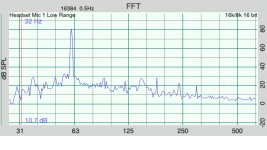
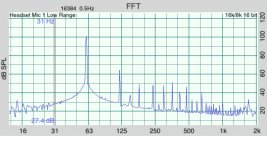
So one Dayton rs 12 sub with the passive gives approximately a 20 hz tune.
This setup again seemed equally sluggish with music but 20hz sine waves were fun.
Frequency Spl of fundamental 2nd harmonic 3rd harmonic
16 85 -17 -31
20 91 -24 -28
25 93 -27 -24
31.5 74 -19 -27
40 95 -26 -43
50 106 -26 -25
63 110 -26 -32
60hz @80db and 100db attached


Last edited:
Next up the $15 special! This is new old stock radio shack 40-1350 subwoofer from the 1990s. Specs on these are great for an acoustic suspension design.
To my surprise this is the most musical sub I have listened to. It beats a dayton rs 12 a peerless xxls 10 a dayton ultimax 12 and a tang band 8 in a 8foot folded horn. To me its equal is a pair of acoustic elegance ibht15s that I have in a dipole setup. The ae subs do better from 30-50hz while the radioshack 12 does better from 50-100hz. Btw as expected the folded horn will get louder but has noticeable resonances.
I know many frown on subjective impressions but this radioshack 12 captures a very realistic kick drum on hotel california from the Eagles Hell freezes over. Bass guitar notes are crisp with great separation in the Alpha Blondy song Allah Tano.
However it's not perfect, distortion below 50 hz is high and it can easily bottom out with low bass. I guess I should say this is the most musical woofer I've heard not subwoofer.
Here's the distortion measurements:
Frequency Spl of fundamental 2nd harmonic 3rd harmonic
16 71 -32 -24
20 71 -27 -22
25 67 -23 -37
31.5 59 -18 -25
40 78 -26 -45
50 101 -24 -25
63 110 -30 -25
attached is 60hz@80db and 100
To my surprise this is the most musical sub I have listened to. It beats a dayton rs 12 a peerless xxls 10 a dayton ultimax 12 and a tang band 8 in a 8foot folded horn. To me its equal is a pair of acoustic elegance ibht15s that I have in a dipole setup. The ae subs do better from 30-50hz while the radioshack 12 does better from 50-100hz. Btw as expected the folded horn will get louder but has noticeable resonances.
I know many frown on subjective impressions but this radioshack 12 captures a very realistic kick drum on hotel california from the Eagles Hell freezes over. Bass guitar notes are crisp with great separation in the Alpha Blondy song Allah Tano.
However it's not perfect, distortion below 50 hz is high and it can easily bottom out with low bass. I guess I should say this is the most musical woofer I've heard not subwoofer.
Here's the distortion measurements:
Frequency Spl of fundamental 2nd harmonic 3rd harmonic
16 71 -32 -24
20 71 -27 -22
25 67 -23 -37
31.5 59 -18 -25
40 78 -26 -45
50 101 -24 -25
63 110 -30 -25
attached is 60hz@80db and 100
Attachments
Whenever I hear of someone claiming a subwoofer sounds "slow" or "boomy" or whatever, I immediately suspect the room.
A big peak in the bass will make anything sound rubbish, but if you use a woofer with limited LF extension, then the room's peak will fill in the low end a bit, and you'll have something listenable.
My recommendation, then, would be to spend some time figuring out how your room is contributing to what you're hearing.
Chris
A big peak in the bass will make anything sound rubbish, but if you use a woofer with limited LF extension, then the room's peak will fill in the low end a bit, and you'll have something listenable.
My recommendation, then, would be to spend some time figuring out how your room is contributing to what you're hearing.
Chris
I don't think it's the distortion I like. The song I mentioned earlier Allah tano causes spikes on my FFT at 60 hz during the bass guitar bits. The radio shack speaker is running low distortion at 60hz. Especially at moderate listening levels. However, I can hear this same sub distorting with hiphop that has 35hz bass and I don't like it.
I also ran the radioshack subwoofer with the passive radiator. Modeled frequency response is very close to sealed, more max spl at tuning as expected but my ears noticed a increase in stored energy.
Couldn't get a good 31.5 hz result.
Here's the distortion measurements:
Frequency Spl of fundamental 2nd harmonic 3rd harmonic
16 71 -22 -26
20 76 -26 -26
25 69 -24 -35
31.5 65 -5 -25
40 77 -26 -33
50 105 -26 -24
63 111 -26 -32
attached is 60hz @80db and 100 db
Couldn't get a good 31.5 hz result.
Here's the distortion measurements:
Frequency Spl of fundamental 2nd harmonic 3rd harmonic
16 71 -22 -26
20 76 -26 -26
25 69 -24 -35
31.5 65 -5 -25
40 77 -26 -33
50 105 -26 -24
63 111 -26 -32
attached is 60hz @80db and 100 db
Attachments
Last edited:
My next experiment was to try a peerless xxls 830842 10" sub with the passive radiator. I made another plywood adapter plate as shown.
I used this sub in my minivan for a few years in a sealed .5 QTC alignment but am know using it sealed in a home office setting.
This passive radiator alignment is similar to one recommend by Peerless.
The sealed alignment sounds tighter to me than the passive radiator especially once you get above 2x resonance (80hz). However it's not perfect, I get some sort of 140hz resonance that shows up in close mike measurements and ruins the crossover to the satellites.
Here's the distortion measurements:
Frequency Spl of fundamental 2nd harmonic 3rd harmonic
16 69 -23 -39
20 94 -32 -25
25 93 -26 -27
31.5 76 -25 -48
40 92 -31 -26
50 103 -32 -30
63 111 -22 -31
attached is 60hz@80db and 100db
I used this sub in my minivan for a few years in a sealed .5 QTC alignment but am know using it sealed in a home office setting.
This passive radiator alignment is similar to one recommend by Peerless.
The sealed alignment sounds tighter to me than the passive radiator especially once you get above 2x resonance (80hz). However it's not perfect, I get some sort of 140hz resonance that shows up in close mike measurements and ruins the crossover to the satellites.
Here's the distortion measurements:
Frequency Spl of fundamental 2nd harmonic 3rd harmonic
16 69 -23 -39
20 94 -32 -25
25 93 -26 -27
31.5 76 -25 -48
40 92 -31 -26
50 103 -32 -30
63 111 -22 -31
attached is 60hz@80db and 100db
Attachments
I don't think it's the distortion I like. The song I mentioned earlier Allah tano causes spikes on my FFT at 60 hz during the bass guitar bits. The radio shack speaker is running low distortion at 60hz. Especially at moderate listening levels. However, I can hear this same sub distorting with hiphop that has 35hz bass and I don't like it.
I've run conventional subs, like the $60 subs from JBL you find at Best Buy, and I've run low distortion subs, like the TC Sounds subs and the old Adire subs and Alpine's SWR line.
What I notice with the TC subs in particular, is that you barely hear anything. For instance, with my sub on, you really can't tell that it's there... until you turn it off.
What's happening here, is that the sub has very low distortion, and all it's really doing is adding some "weight" to the music.
With subs like the JBL, they were very noticeably in the mix.
Subwoofers can produce quite a bit of distortion, and our hearing mechanism is very poor at low frequencies. Combine those two things, and often what you perceive with an inexpensive subwoofer is the harmonics, not the fundamental. IE, if a cheap JBL sub is playing 60hz, the 2nd harmonic at 120Hz and the 3rd harmonic at 180hz is often more audible than the fundamental at 60hz.
Patrick thanks for your input. I've spent alot of time reading your posts and value your knowledge. In the adjacent room I have some david speakers that I've built from bfm plans. So basically two horn loaded woofer autotubas in one room. I would consider this a low distortion setup above 50hz.
However, if I play the same song on the radioshack sub I am getting more detail in the bass guitar line. The david speaker will hit a note and due to a room node or resonance in the horn the note will have a slow decay and it gets blurred with the next note. (That being said I have so much more headroom and imaging with the davids, still love them)
The radioshack has less stored energy. I believe this is due to the low MMS of 45 grams. Also the suspension is very compliant at 1.2372 mm/N. I like to compare this to a car suspension a compliant suspension will get right down in the pothole. So if I a kick drum hit comes along a compliant speaker will rise to the occasion. My theory is that the dayton rs suspension is too tight. With a CMS of .27mm/N a kick drum hit comes along and it just doesn't rise to produce the peak, just low distortion mush.
However, if I play the same song on the radioshack sub I am getting more detail in the bass guitar line. The david speaker will hit a note and due to a room node or resonance in the horn the note will have a slow decay and it gets blurred with the next note. (That being said I have so much more headroom and imaging with the davids, still love them)
The radioshack has less stored energy. I believe this is due to the low MMS of 45 grams. Also the suspension is very compliant at 1.2372 mm/N. I like to compare this to a car suspension a compliant suspension will get right down in the pothole. So if I a kick drum hit comes along a compliant speaker will rise to the occasion. My theory is that the dayton rs suspension is too tight. With a CMS of .27mm/N a kick drum hit comes along and it just doesn't rise to produce the peak, just low distortion mush.
My next driver is a dayton 12" ultimax. This is with the passive radiator.
When driver hard this sub has high 2nd harmonic distortion and it made it subjectively louder but to me it made the fundamental harder to hear. Comparing this to a dipole setup with AE IB15ht the AE subs captured the deep fundamental of the five string bass in Bela Fleck's "flight of the cosmic hippo" better.
Couldn't get a good 16hz measurement.
Here's the distortion measurements:
Frequency Spl of fundamental 2nd harmonic 3rd harmonic
16 66 -12 -26
20 82 -26 -28
25 88 -22 -34
31.5 80 -23 -44
40 66 -17 -31
50 113 -33 -32
63 111 -39 -46
attached is 60hz@80db and 100db
When driver hard this sub has high 2nd harmonic distortion and it made it subjectively louder but to me it made the fundamental harder to hear. Comparing this to a dipole setup with AE IB15ht the AE subs captured the deep fundamental of the five string bass in Bela Fleck's "flight of the cosmic hippo" better.
Couldn't get a good 16hz measurement.
Here's the distortion measurements:
Frequency Spl of fundamental 2nd harmonic 3rd harmonic
16 66 -12 -26
20 82 -26 -28
25 88 -22 -34
31.5 80 -23 -44
40 66 -17 -31
50 113 -33 -32
63 111 -39 -46
attached is 60hz@80db and 100db
Attachments
The sound is considered relative, if it is really good, not up from 12 to 15, the original 15 product will give the best sound quality.
Do you mean I should try the Peerless by Tymphany STW-350F-188PR01-04?
That might be fun.
Next up was to try the ultimax 12 sealed. Voice coils in series for 4 ohm load.
Here's the distortion measurements:
Frequency Spl of fundamental 2nd harmonic 3rd harmonic
16 64 -28 -21
20 68 -28 -20
25 70 -25 -24
31.5 91 -35 -29
40 80 -24 -35
50 105 -27 -29
63 111 -26 -39
attached is 60hz@80db and 100db
Here's the distortion measurements:
Frequency Spl of fundamental 2nd harmonic 3rd harmonic
16 64 -28 -21
20 68 -28 -20
25 70 -25 -24
31.5 91 -35 -29
40 80 -24 -35
50 105 -27 -29
63 111 -26 -39
attached is 60hz@80db and 100db
Attachments
I believe there is valuable information to be gleaned from he data you've gathered. I must admit it's a bit daunting, though. Would you be willing to share what key markers you are looking for as indicators of better-or-worse performance?
In addition, I have questions about some numbers that caught my eye: For example, does the spl variation across frequencies measured help or hinder your comparison of fundamentals vs harmonics? Does a smaller number of harmonic relative to fundamental desirable? Why show only images of 80 and 100db distortion plots at 60hz what about other frequencies? What about distortion at frequencies below the fundamental (non-harmonic?).
It would be helpful to have additional insight about how you are interpreting the results to quantify your perception of a good sounding subwoofer.
Thanks for the thread!
Six.
In addition, I have questions about some numbers that caught my eye: For example, does the spl variation across frequencies measured help or hinder your comparison of fundamentals vs harmonics? Does a smaller number of harmonic relative to fundamental desirable? Why show only images of 80 and 100db distortion plots at 60hz what about other frequencies? What about distortion at frequencies below the fundamental (non-harmonic?).
It would be helpful to have additional insight about how you are interpreting the results to quantify your perception of a good sounding subwoofer.
Thanks for the thread!
Six.
What I'm missing here are the Impedance plots of each of your set-ups. Comparing only distortion plots with subjective judgements leads to the strange result that they do not seem to be much correlated.
It would be better to know also the Qtc and Group Delay, which can be derived from an impedance plot.
Some of your remarks seem correlated to Group Delay.
It would be better to know also the Qtc and Group Delay, which can be derived from an impedance plot.
Some of your remarks seem correlated to Group Delay.
- Home
- Loudspeakers
- Subwoofers
- A tale of 12" subwoofers, distortion and 15 dollars.
